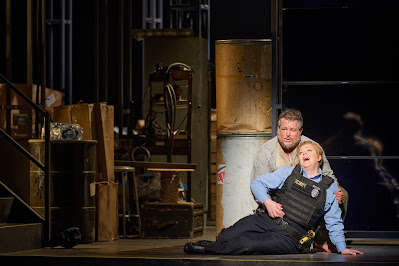Reviewed James Karas
Opera Atelier, a prime example of civilization in Toronto, has produced Gluck’s Orpheus and Eurydice for its fall season. There are three versions of Gluck’s opera, the Vienna version of 1762 in Italian, the Paris version of 1774 in French and the Berlioz version of 1859 to a French libretto by Pierre-Louis Moline. Marshall Pynkoski, the Co-Artistic Director of Opera Atelier, has produced all three versions and for this year he has chosen to reprise the Paris version that he directed in 2007 with Colin Ainsworth in the lead role.
Tenor Answorth, still looking boyish, sings Orpheus again this year with soprano Mireille Asselin as Eurydice and soprano Anna-Julia David as Amour. The French version changed the vocal range of Orpheus from castrato to countertenor and now is frequently sung by tenors. Pynkoski has made a major infusion of ballet into the production which fits perfectly with Opera Atelier’s style of providing plenty of ballet dances thanks to Co-Artistic Director and Choreographer Jeannette Lajeunesse Zingg.
It is a beautiful production starting with Ainsworth’s supple lyrical voice and wonderful delivery. The opera has few vocal flourishes for the tenor but he does have to maneuver through deep grief at the death of his wife on the day of their marriage to having to convince the Furies to let him into Hades and then try to endure the temptation to look at Eurydice on their way out of the depths of Hades to the earth. Alas, he succumbs to her pleas and looks at disastrous results: she dies. Her death does have a positive aspect for us because Gluck composed the beautiful “J’ai perdu mon Euridice” aria that has the distinction of being the first big operatic hit.
Asselin has a lovely and delicious soprano voice and we feel her distress as she expresses doubts about Orpheus still loving her when he refuses to even look at her. Excellent work. David does a fine job in the relatively small role of Amour.
Zingg as expected choreographs gorgeous ballet sequences for the Atelier Ballet. The choruses are handled by the Nathaniel Dett Chorale and the Tafelmusik Chamber Chοir. The inimitable Tafelmusik Orchestra, another mark of civilization in Toronto, is conducted by David Fallis.
Gerard Gauci, Opera Atelier’s Resident Set Designer, designs the set with emphasis on colour, beauty and simplicity. The fires of hell are indicated at the back of the set although there are no dramatic efforts to provide idyllic dales or overdo the terrors of Hades but what we do get is effective.
There was great emphasis on a hazy or foggy Hades. There may have been a hitch, I suppose, and someone kept his finger on the haze making machine for far too long. Some of the dancers were hard to see as were the surtitles above the stage. Much of the theatre was enveloped in haze but I think it was a simple glitch in an otherwise wonderful production.
______________________




